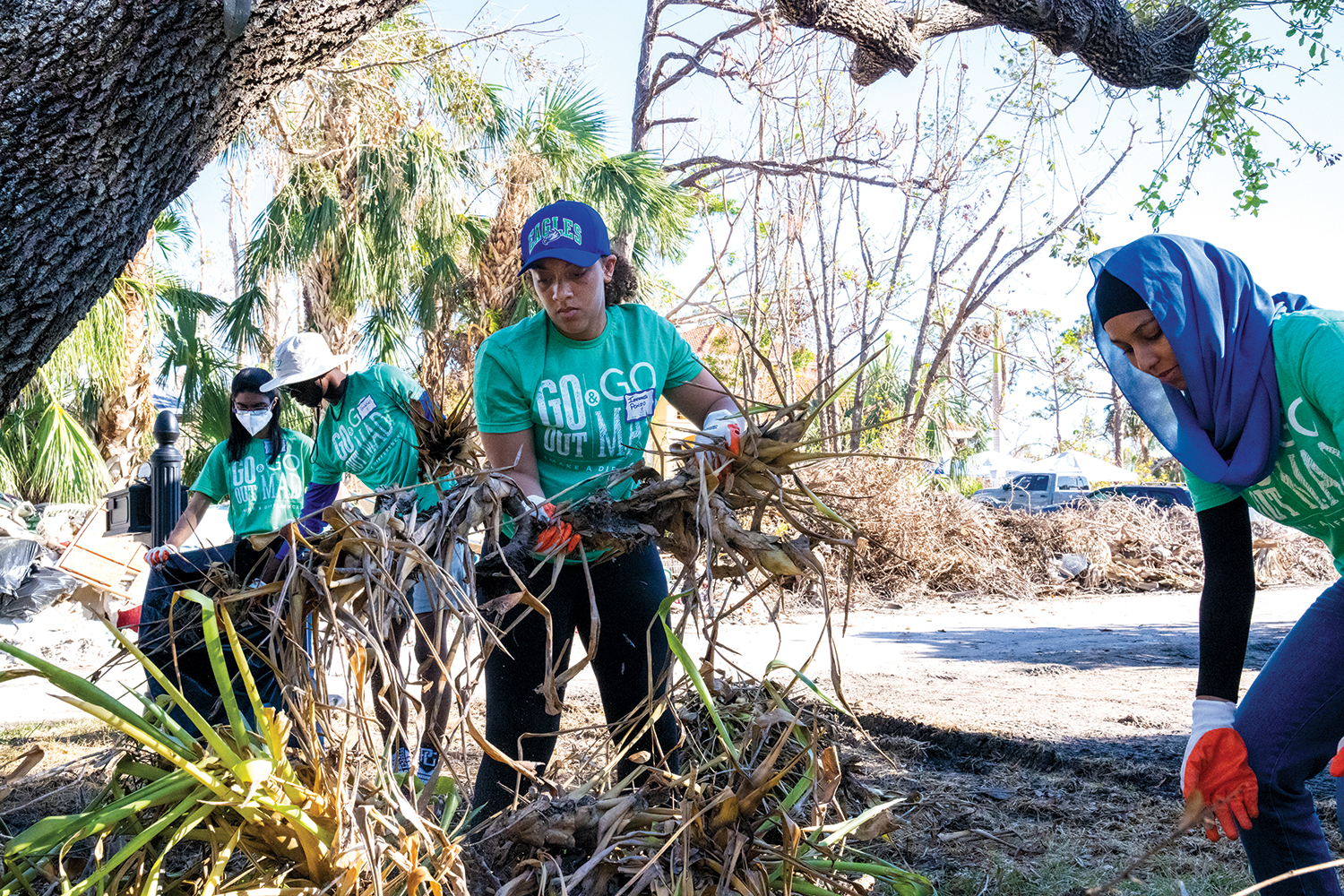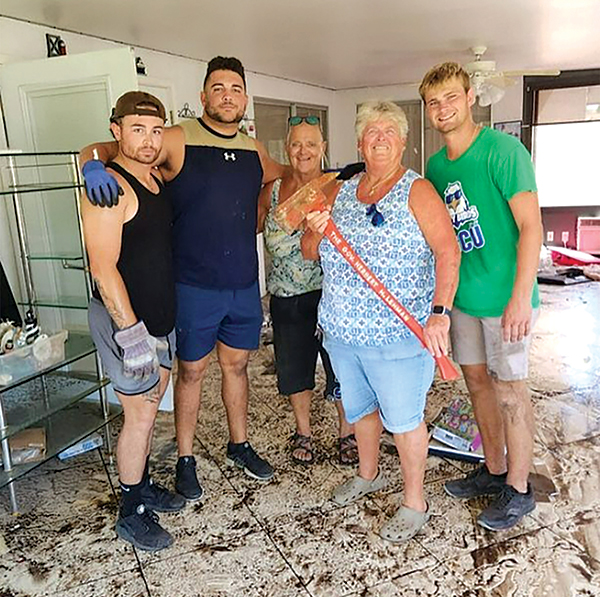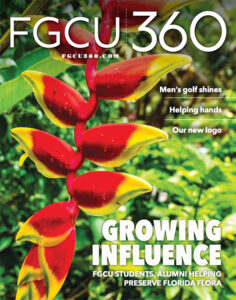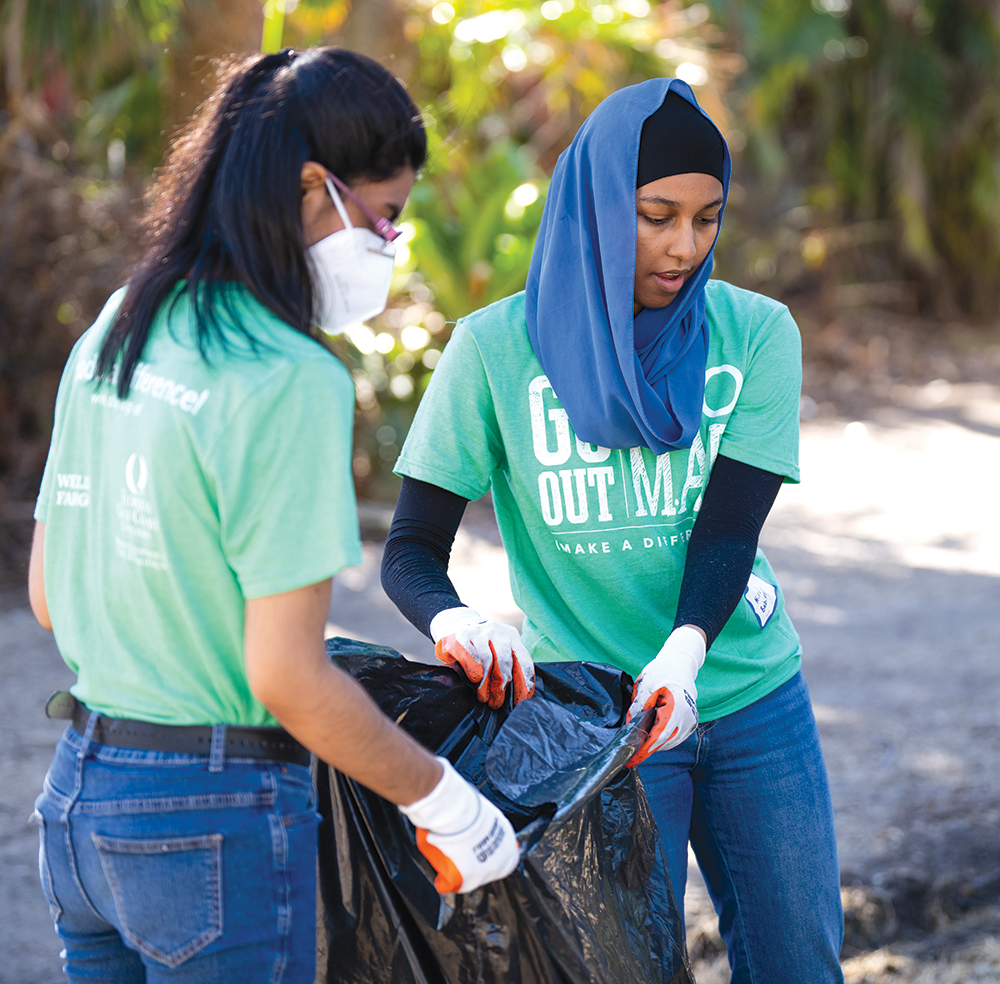Eagles reach out to aid communities hit hard by Ian
13 - minute read
Hurricane Ian’s rampage through Southwest Florida Sept. 28 left few people untouched. Its relentless winds, immense storm surges and plodding pace tore apart lives, homes, businesses and bridges. And, like Irma five years earlier, it also ripped a two-week hole in Florida Gulf Coast University’s fall semester.
As the region faced the overwhelming job of recovery, many FGCU students had time on their hands. They could have escaped the discomforts of power and internet outages, the undrinkable water and the lack of readily available food. They could have headed to some untouched east coast beach for a carefree week. Instead, many stayed or felt moved to return from safer locales, becoming their own force of nature.
As soon as the storm passed, they ventured out of their safe places, met up and began helping. They checked on family, friends and colleagues. Then they reached out to countless people they didn’t know but about whom they knew this: Virtually all had just been through a devastating event and needed assistance.

They waded through flooded streets and homes, hauling off tons of ruined furniture, sodden drywall, downed trees and debris. They distributed water, food and blankets. Perhaps most important of all, they listened to people who needed a sympathetic ear. Whatever the need, there were FGCU students and personnel figuring out how to help.
Plan in place to volunteer
Senior Ben Hermiston, an Iowa native, knew he’d be helping even before the storm arrived. The Lutgert College of Business finance major, member of the men’s cross country team and president of FGCU’s Student Athletics Advisory Committee, said he and some friends planned that in advance. His rationale: “Most of us aren’t from here. But we’ve been here now for two or three or four years. We call it home, but you don’t really know it’s home until you go through something like this and help.”
Before the winds died down the day after the storm, he and those friends connected by phone, targeted some communities and set out. What began as a group of five grew throughout the week to about 150 volunteers.
They ran into Mary Voytek, associate professor of art, at a hardware store. Her house had been inundated, and she needed help.

“FGCU student volunteers were amazing,” she said. “I had them for three days, and they moved mountains of ruined possessions to the street and filled infinite wheelbarrows with muddy floodwater. Their wonderful spirits beaming with concern and kindness will always be remembered. It gives me hope for our future at a time when my world looks pretty bleak.”
The group grew so large it split into teams of 10 and went to different places to maximize their efforts.
“We were basically a full-on demo repair team for the homeowners,” Hermiston says. “We were also talking to people just to calm them down.”
They were a cross section of student-athletes – members of the cross country, volleyball, beach volleyball, swimming and diving, baseball and softball teams. There were physical therapy students and members of the Dirty Birds fan club and anyone else who answered the call.
He estimates they worked on 300 to 400 houses over 10 days. At night, they’d plan for and post the next day’s schedule on various social media sites to alert volunteers.
“Some of the people we helped tried to pay us,” Hermiston said. “We said, ‘That’s not what we’re here for.’ “It was an eye-opening experience,” he reflected about two weeks after the marathon effort ended and classes resumed. “I wish I could still be doing it every day but with school, practice, competitions, studying… I wish I could just keep doing it.”
Leading from the floor
Student Body President Grace Brannigan could have spent the hurricane and its aftermath in Orlando with her family. Instead, she claimed a piece of the Alico Arena floor to sleep on and stuck it out with the 278 students who found themselves with few other options.
“You can’t claim to lead a community, especially in a crisis as visible as a hurricane, and flee the scene,” she said.
President Mike Martin and Director of Emergency Management Ruth Rodrigues visited the arena after the storm, and Brannigan stepped up to help.

She landed the job of organizing students to help at the FGCU Emergency Operations Center and FGCU Campus Food Pantry for the next week. After that, “I made sure I was there to provide a student perspective when decisions were being made,” she said.
She helped create informational videos, wrote communications to students and “tried my best when they were making decisions involving students to answer questions I felt would come up.”
The senior with a double major in history and political science and a minor in philosophy said she “learned more about leadership in the last month than in all the time before. At the end of the day, it was far more than I’d bargained for as (Student Government) president, but that’s not to say I regret it.”
Now back in her apartment in West Lake Village, she’s proud of the FGCU community and how so many people stepped up to help one another and the people of Southwest Florida.
A proud, but weary president
President Mike Martin hadn’t been here long when Hurricane Irma struck in 2017, and he found himself overseeing an emergency effort. Five years later, he was once again sleeping on the floor of the Campus Support Complex to be close by throughout the storm and its aftermath.
He, too, is proud of how university personnel responded, ensuring the campus and students were safe and seeing to the larger community’s needs.
“I’m getting a lot of calls about students, faculty and staff helping out community members,” he said in Ian’s aftermath. “It’s indicative of our commitment to service-learning. It’s baked into the culture of the place. A lot of the students here are from the region or have adopted it and feel a responsibility to serve. The staff and faculty do, too. Everyone wanted to do it for the right reasons.”
Social work skills come in handy
Tom Felke, associate dean of Marieb College of Health & Human Services and a social work professor, maintains close connections to the area’s social services network. He started monitoring social networks to see where there might be help, which groups were operating, which needed volunteers.
He quickly assembled a map of services – where to get food, housing, help from United Way, and locations of disaster assistance. He also included agencies that needed volunteers. The map was published on the university’s Hurricane Ian resources webpage.

“People started sharing it, searching for whatever resources they needed,” Felke said. Several of his current and former students called to ask where they might be useful.
He and Marieb Interim Dean Shawn Felton contacted students and faculty. Some were ready to help, and others needed help. Three occupational therapy faculty members lost their homes.
Felke deployed those who could help to places they were needed – the Lee County Emergency Operations Center, Community Cooperative, Salvation Army – and the others to places where they could find assistance.
“It was really awesome to see the faculty, staff and students working alongside one another and to see them extend out with alumni into the community,” Felke said.
With the immediate crisis passing, there remained many needs to be met. Some students had internships at places too damaged to return, so they were working to place them with the agencies dealing with the storm’s aftermath.
“These students keep churning away,” Felke said. “This is what we train them for. These are the moments that health care and human service professionals get called on. They really answered the bell and stepped up in a big way.”
Heading in the wrong direction proves right
Assistant professor Kevin Minner moved to the area and started teaching occupational therapy at FGCU in August. When he and his fiancée, Lindsey Stiefvater, learned the storm was approaching Tampa, they decided to head north to help Stiefvater’s parents in Tarpon Springs.
Things turned out differently, and they found they were in a position to help their Lee County friends once the storm passed. Stiefvater sent out a Facebook appeal and in two hours had $2,000 in donations in her Venmo account. The pair loaded up cases of water, peanut butter, bread, granola bars, diapers, sanitary wipes and batteries and headed south.
“We met Tom (Felke) at the Lee County Emergency Operations Center and handed him what we had,” Minner said. “Then we helped take censuses and dropped off cat litter and dog food at the Lee County Humane Society.”
When classes resumed, Minner was impressed that his students continued to want to help.
“They aren’t just volunteering, they are also putting their OT minds to work, creating adaptive-ready hurricane kits for people with disabilities, thinking about how to teach people ergonomic ways to lift boxes, evacuation protocols for communities with a high proportion of people with wheelchairs who might not get out because of it,” Minner said.
“And we are taking a look at organizations that evacuated really well. Why didn’t others do as well? We want to shift ideas so it’s better next time.”
Special mission for Salvation Army
Sarah Rafiq, who earned a bachelor’s degree in psychology in 2015 and a master’s in social work in 2019 at FGCU, directs the Bonita Springs service center of The Salvation Army. The Florida native has lived through hurricanes before, but “this was a terrifying experience. It was the scariest one so far,” she said.
When she got to the service center, which had no power and little cell service, she called volunteers to help distribute food, water and necessities because only one of her two employees could work. The other had lost her home.
“The number of volunteers from FGCU made a huge difference,” Rafiq said. “We could not have done it without them. We probably had 15 or 20 for three or four days.”
Sarah Margolis, a third-year student in the doctor of physical therapy program at Marieb College, was among the volunteers.
“They didn’t have power but had a palette of produce that would go bad, so we created a ‘free food’ sign and stood at the side of the road,” Margolis said.
“I’ve never been to that area and seen such poverty,” she said. “Most were on bicycles or came by foot. Rather than having them juggle a box of prepackaged meals on bicycles, we gave them bags and stocked those.”
When Rafiq asked the students if they would like her to sign service-learning forms so they could get credit for volunteering, “none of them wanted me to sign anything,” she said. “It came from the heart. They belong to this community, and they were in it to help other people who were less fortunate. You could see they were affected by what they were seeing.”
Fraternity brothers lend a hand in Naples
Naples business owner Krista Bazzard-Jones was helping at a condominium complex in Naples when she ran into a group of FGCU students doing the same. It turned out to be a group of Sigma Phi Epsilon brothers.
“We chose Naples because we felt everybody was headed to the Fort Myers area,” said Hector Zerbo, a senior from Fort Lauderdale majoring in criminal justice. “This is the community we live in. It’s devastating to see a hurricane hit that hard and impact so many people.”
They helped at the condo complex, and when Bazzard-Jones received a request from a man asking for help for his brother, they headed to Old Naples to the 100-year-old home. Zerbo said they ripped out the moldy drywall, removed trash and helped tidy things up.
“The boys took so much care,” Bazzard-Jones said. “I’m blown away. I’m a mom myself and found this so impressive.”
First-year students aid community
Freshmen Riley Houle and JJ Dourm were friends when they lived in Crystal River and are roommates at FGCU. The pair returned to their hometown for the hurricane and saw what had happened in Fort Myers on television.
They talked to the Crystal River High School principal, who helped them promote a drive to collect supplies during a football game. People donated blankets, toiletries, canned food and hygiene products.
“It was definitely more than we expected,” he said.
They loaded his mother’s GMC Yukon and drove south, leaving the donations with an American Red Cross group to distribute.
“It felt really good,” Houle said. “This is our home now. It was really nice to give back to a place that’s done well for me.”

Two FGCU students learn food-service philanthropy
By Kaitlyn Snook
Since opening FK Your Diet in 2018, restaurateur Doug Miller has aimed to inspire and assist foster kids just like he was.
When Hurricane Ian hit, Miller and his FK employees — including two Florida Gulf Coast University students — stepped up in a big way. (FK stands for foster kids, by the way.)
FGCU seniors Christian Cucinotta, a sociology major from Philadelphia, and Noah Smith, an entrepreneurship major from Cape Cod, have worked at the Fort Myers FK location for two years.
“It doesn’t feel like a restaurant,” Cucinotta said. “It feels like a family.”
When Ian hit Sept. 28, Miller paid for his employees to stay in a Sunrise hotel where they rode out the storm. Hours later, they were back at work.
Using the FK Sunrise location, one of five in the state, Cucinotta and other employees cooked until midnight making more than 1,000 meals, then delivered them to Fort Myers early the next morning. Meanwhile, Smith and others dealt with the power outage in Fort Myers.
“We just served up everything that was gonna go bad,” Smith said.
Despite having lost power, water and air conditioning, Cucinotta and Smith fired up the gas appliances and cooked so they could provide free hot meals to the many people who needed them.
“Help as many people as we can,” Cucinotta said. “That’s the goal.”
Students from out of state surprised by storm’s impact
By Chloe Dumas
Sunny weather and beaches lure students from cold-weather states, but attending school in Florida also means enduring hurricane season. Many non-Floridians have no idea what that can mean.
Some 16% of FGCU students come from out of state, according to FGCU enrollment numbers.
Among those is sophomore psychology student Sophie Munson of Wayzata, Minnesota. During Hurricane Ian, Munson evacuated North Lake Village to stay with extended family in Naples, where she found herself without power or cell service. Unable to contact her family, she chose to return to Wayzata in the days following the storm.
“My mom was continuously trying to reach me,” Munson said. “There’s nothing scarier than not being able to update your loved ones during something as devastating as this.”
Casey Leach, another sophomore psychology student from Hockessin, Delaware, applied to FGCU knowing there was hurricane risk although she had never experienced one. Riding out the storm alone, she felt ill prepared and homesick.
“Having my family so far away and facing the storm alone was hard,” Leach said. “Communicating through the phone is not the same as having them with me — knowing we were all safe.”
Her message to other out of staters when storms approach: “As soon as you hear about a potential storm, be proactive,” Leach said. “Have a plan in place.”
–Kaitlyn Snook and Chloe Dumas are interns in University Marketing & Communications.